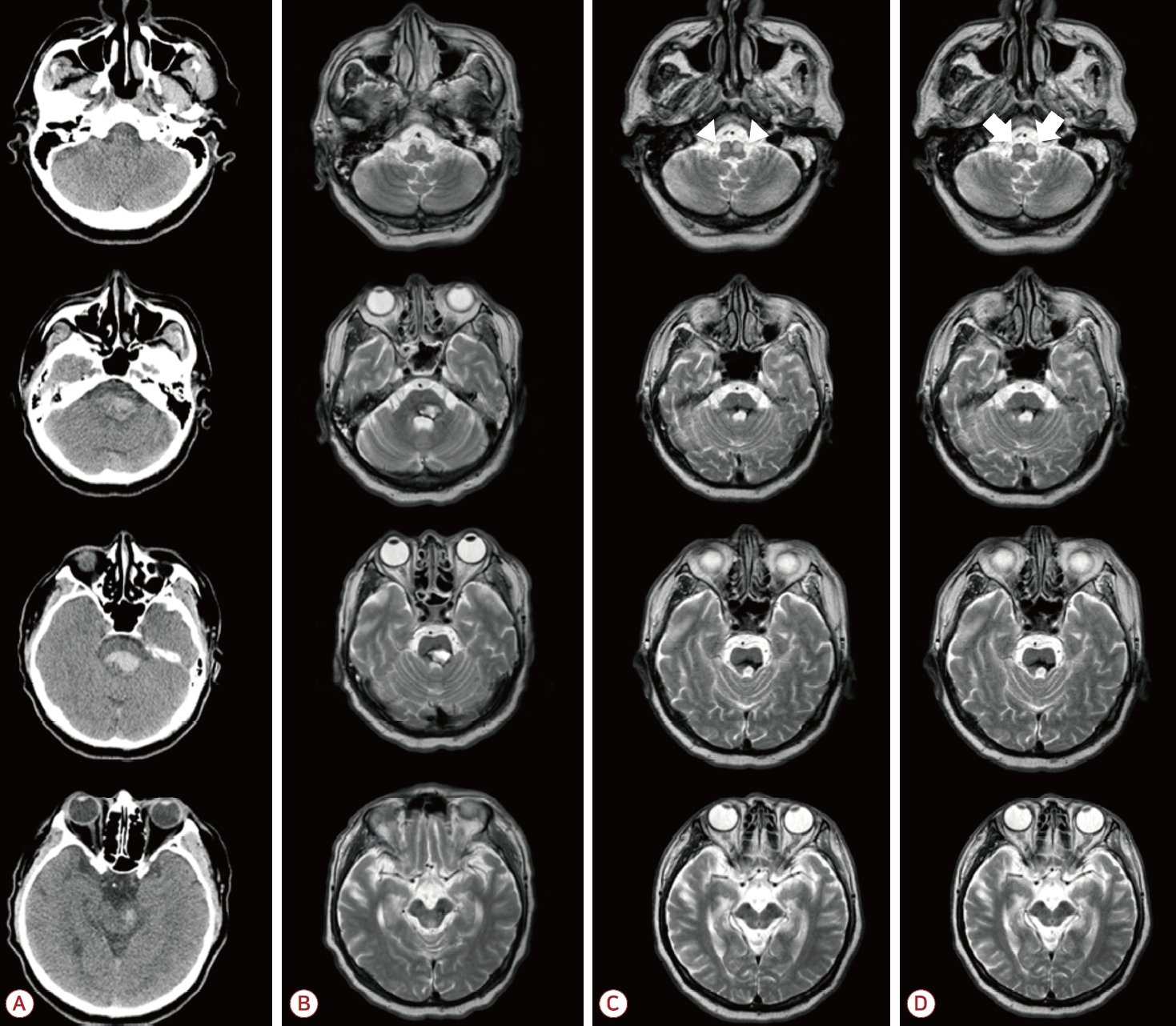4달 전 다리뇌, 왼쪽 중뇌와 소뇌다리 부위의 출혈로 인해 혼미 상태인 59세 남자가 수면무호흡증으로 의뢰되었다(Fig. 1-A, B). 환자는 평소 가벼운 코골이가 있었고, 병간호 기간 동안 보호자가 가끔 무호흡을 관찰했으나, 최근 무호흡 빈도가 급격히 늘어났다고 하였다. 신경계진찰에서 환자는 경직성사지마비, 양쪽 발에서 바뱅스키징후가 양성이었고, 입천장떨림을 보였다. 뇌자기공명에서 양쪽 올리브비대변성(bilateral hypertrophic olivary degeneration)이 확인되었다(Fig. 1-C, D). 수면다원 검사에서 총 수면시간은 9시간 39분, 수면잠복기는 1분, 렘수면잠복기는 7시간 2분, 수면효율은 98.3%였으며, N1 (74.4%) 증가, N2 (21.3%) 감소, 렘수면(4.3%) 감소 소견을 보였다. 심한 수면무호흡(무호흡-저호흡지수 67.8/h)이 확인되었으나, 대부분은 중추무호흡(62.1/h)이었다. 렘수면 중 중추무호흡은 없었다. 체인-스톡스호흡도 없었다(Fig. 2-A). 입천장떨림은 수면 중에도 지속되었다(Fig. 2-B). 양쪽 올리브비대변성은 뇌줄기출혈 후 드물게 나타나는데, 아래올리브핵, 적핵, 반대편 치상핵(dentate nucleus)으로 이루어지는 Guillain-Mollaret 삼각 내 연접 변성으로 인한 올리브핵의 이차 퇴행 변화이다[1]. 동반되는 뇌줄기에 존재하는 호흡 중추의 손상으로 인해 지연되어 중추수면무호흡이 발생할 수 있다[2]. 증례의 경우 다리뇌 병변으로 숨뇌의 호흡 회로와의 연결이 손상되어 중추수면무호흡이 발생한 것으로 보인다. 본 증례는 뇌줄기출혈 후 지연 발생한 양측 올리브핵비대변성을 동반한 수면 중에도 지속되는 입천장떨림과 중추수면무호흡을 보고하여 뇌줄기 병변과 관련되어 다양한 신경계 합병증이 지연 발생할 수 있음을 환기하고자 한다.
| J Korean Neurol Assoc > Volume 41(2); 2023 > Article |
|
Figure 1.
Brain CT and follow-up MRI in the patient. (A) Brain CT images show hemorrhages in the pons, left midbrain, and left middle cerebellar peduncle. (B) Follow-up MRI 2 months later show high signal intensity lesions with peripheral dark rim on T2 weighted images in the same lesions. (C) Follow-up MRI 4 months later show newly appeared T2 high signal intensity involving bilateral olivary nucleus of medullar indicating bilateral hypertrophic olivary degeneration (arrowheads). (D) Follow-up MRI 5 months later show slightly increased size of olivary nucleus (arrows). CT; computed tomography, MRI; brain magnetic resonance imaging.

Figure 2.
Ten-minute excerpt from polysomnography and 21-second excerpts of chin EMG and ECG. (A) Polysomnography shows repetitive central sleep apneas without chest and abdomen movement indicating respiratory effort. (B) Chin EMG shows phasic activity about 2 Hz, reflecting palatal tremors. ECG rhythm is not coincidence with chin EMG. EEG; electroencephalography, EOG; electrooculography, EMG; electromyography, ECG; electrocardiography.

- TOOLS



 PDF Links
PDF Links PubReader
PubReader ePub Link
ePub Link Full text via DOI
Full text via DOI Download Citation
Download Citation Print
Print




